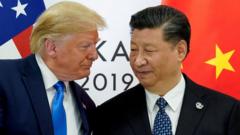As China's military influence expands, Japan issues warnings about flight safety and the potential for collisions.
**Tensions Rise as Chinese Fighter Jet Approaches Japanese Military Plane**

**Tensions Rise as Chinese Fighter Jet Approaches Japanese Military Plane**
A Chinese fighter jet's risky maneuvers near a Japanese aircraft over the Pacific prompt serious concerns from Japan.
Japan's defense ministry has raised alarms following a recent incident where a Chinese J-15 fighter jet flew dangerously close to a Japanese P-3C patrol aircraft operating over international waters in the Pacific. This occurrence, which happened over the weekend, is viewed as part of the growing military assertiveness exhibited by China in the region.
In a statement released by Japan’s Defense Ministry, officials disclosed that the Chinese fighter came within 150 feet of the Japanese surveillance plane on Saturday, with an even more alarming approach the following day as it cut across the aircraft's flight path within 3,000 feet. Such maneuvers raised fears of a possible collision, prompting Japan’s Defense Minister, Gen. Nakatani, to voice grave concerns during a security committee meeting.
The Chinese jet was reportedly operating from the Shandong aircraft carrier, one of two carriers that had recently been engaged in exercises further from the Chinese coast than previously observed. This marks a significant display of China's expanding military capabilities in the Pacific region.
Gen. Yoshihide Yoshida, Japan's Chief of Joint Staff, underscored the worry that the proximity of the Chinese fighter, reportedly armed with missiles, posed a significant danger, although determining the intent of such maneuvers remained challenging.
Chinese officials retaliated by suggesting that Japan’s actions contributed to the incident. Lin Jian, the spokesperson for China's Foreign Ministry, stated during a press conference that Japan's perceived provocations were to blame for the close encounters, urging a more objective evaluation of the situation.
This incident echoes a similar episode from 2022 when a Chinese fighter jet approached an American military aircraft within 20 feet over the South China Sea, highlighting ongoing tensions and potential risks associated with military encounters in contested airspaces.
The context of heightened military activity from China, combined with Japan's ongoing concerns, illustrates the precarious nature of security dynamics in the Pacific as both countries navigate their respective military postures.
In a statement released by Japan’s Defense Ministry, officials disclosed that the Chinese fighter came within 150 feet of the Japanese surveillance plane on Saturday, with an even more alarming approach the following day as it cut across the aircraft's flight path within 3,000 feet. Such maneuvers raised fears of a possible collision, prompting Japan’s Defense Minister, Gen. Nakatani, to voice grave concerns during a security committee meeting.
The Chinese jet was reportedly operating from the Shandong aircraft carrier, one of two carriers that had recently been engaged in exercises further from the Chinese coast than previously observed. This marks a significant display of China's expanding military capabilities in the Pacific region.
Gen. Yoshihide Yoshida, Japan's Chief of Joint Staff, underscored the worry that the proximity of the Chinese fighter, reportedly armed with missiles, posed a significant danger, although determining the intent of such maneuvers remained challenging.
Chinese officials retaliated by suggesting that Japan’s actions contributed to the incident. Lin Jian, the spokesperson for China's Foreign Ministry, stated during a press conference that Japan's perceived provocations were to blame for the close encounters, urging a more objective evaluation of the situation.
This incident echoes a similar episode from 2022 when a Chinese fighter jet approached an American military aircraft within 20 feet over the South China Sea, highlighting ongoing tensions and potential risks associated with military encounters in contested airspaces.
The context of heightened military activity from China, combined with Japan's ongoing concerns, illustrates the precarious nature of security dynamics in the Pacific as both countries navigate their respective military postures.





















